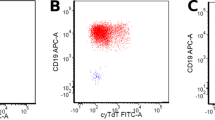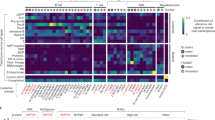Abstract
The expression of the chondroitin sulfate proteoglycan neuron-glial antigen 2 (NG2) has been demonstrated in association with rearrangement of the mixed lineage leukemia (MLL) gene in acute leukemia, but the frequency of NG2 expression in adult acute lymphoblastic leukemia (ALL) is yet unknown. We evaluated NG2 expression in 313 adult ALL patients by flow cytometry and simultaneously determined MLL rearrangement in 120 adult patients out of them with B-precursor ALL by reverse transcription-polymerase chain reaction and fluorescence in situ hybridization. A total of 57% of pro-B ALL, 2% of common ALL and 20% of pre-B ALL were NG2 positive, but NG2 was absent in T-ALL and mature B-ALL. In B-precursor ALL, NG2 expression was significantly associated with a CD10−/CD34−/CD24−/CD65s+/CD15+/CD13−/CD33− phenotype and showed a sensitivity, specificity and positive predictive value of 0.89, 0.89, and 0.93 for MLL rearrangement, respectively. NG2 was positive in three patients without detectable MLL rearrangement and negative in eight patients with MLL-AF4 transcripts. However, NG2 predicted with a 100% accuracy MLL rearrangement among patients disclosing a CD65s+ and/or CD15+ immunophenotype. In summary, NG2 adds to a more precise identification of high-risk adult ALL and should therefore be included into diagnostic marker panels. As NG2 is negative in non-malignant hematopoietic cells, this novel antigen might also serve in future studies as a powerful marker in monitoring minimal residual disease.
This is a preview of subscription content, access via your institution
Access options
Subscribe to this journal
Receive 12 print issues and online access
$259.00 per year
only $21.58 per issue
Buy this article
- Purchase on Springer Link
- Instant access to full article PDF
Prices may be subject to local taxes which are calculated during checkout

Similar content being viewed by others
References
Huret JL . 11q23 rearrangements in leukaemia. Atlas Genet Cytogenet Oncol Haematol 2001; URL: http://www.infobiogen.fr/services/chromcancer/Anomalies/11q23ID1030.html
Griesinger F, Elfers H, Ludwig WD, Falk M, Rieder H, Harbott J et al. Detection of HRX-FEL fusion transcripts in pre-pre-B-ALL with and without cytogenetic demonstration of t(4;11). Leukemia 1994; 8: 542–548.
Pui CH, Frankel LS, Carroll AJ, Raimondi SC, Shuster JJ, Head DR et al. Clinical characteristics and treatment outcome of childhood acute lymphoblastic leukemia with the t(4;11)(q21;q23): a collaborative study of 40 cases. Blood 1991; 77: 440–447.
Behm FG, Raimondi SC, Frestedt JL, Liu Q, Crist WM, Downing JR et al. Rearrangement of the MLL gene confers a poor prognosis in childhood acute lymphoblastic leukemia, regardless of presenting age. Blood 1996; 87: 2870–2877.
The Groupe Français de Cytogénétique Hématologique. Cytogenetic abnormalities in adult acute lymphoblastic leukemia: correlations with hematologic findings and outcome. A collaborative study of the groupe français de cytogénétique hématologique. Blood 1996; 87: 3135–3142.
Pui CH, Gaynon PS, Boyett JM, Chessells JM, Baruchel A, Kamps W et al. Outcome of treatment in childhood acute lymphoblastic leukaemia with rearrangements of the 11q23 chromosomal region. Lancet 2002; 359: 1909–1915.
Faderl S, Kantarjian HM, Talpaz M, Estrov Z . Clinical significance of cytogenetic abnormalities in adult acute lymphoblastic leukemia. Blood 1998; 91: 3995–4019.
Janssen JWG, Ludwig WD, Borkhardt A, Spadinger U, Rieder H, Fonatsch C et al. Pre-pre-B acute lymphoblastic leukemia: high frequency of alternatively spliced ALL1-AF4 transcripts and absence of minimal residual disease during complete remission. Blood 1994; 84: 3835–3842.
Ludwig WD, Rieder H, Bartram CR, Heinze B, Schwartz S, Gassmann W et al. Immunophenotypic and genotypic features, clinical characteristics, and treatment outcome of adult pro-B acute lymphoblastic leukemia: results of the German multicenter trials GMALL 03/87 and 04/89. Blood 1998; 92: 1898–1909.
Smith FO, Rauch C, Williams DE, March CJ, Arthur D, Hilden J et al. The human homologue of rat NG2, a chondroitin sulfate proteoglycan, is not expressed on the cell surface of normal hematopoietic cells but is expressed by acute myeloid leukemia blasts from poor-prognosis patients with abnormalities of chromosome band 11q23. Blood 1996; 87: 1123–1133.
Nishiyama A . NG2 cells in the brain: a novel glial cell population. Hum Cell 2001; 14: 77–82.
Behm FG, Smith FO, Raimondi SC, Pui C-H, Bernstein ID . Human homologue of the rat chondroitin sulfate proteoglycan, NG2, detected by monoclonal antibody 7.1, identifies childhood acute lymphoblastic leukemias with t(4;11)(q21;q23) or t(11;19) (q23;p13) and MLL gene rearrangements. Blood 1996; 87: 1134–1139.
Hilden JM, Smith FO, Frestedt JL, McGlennen R, Howells WB, Sorensen PHB et al. MLL gene rearrangement, cytogenetic 11q23 abnormalities, and expression of the NG2 molecule in infant acute myeloid leukemia. Blood 1997; 89: 3801–3805.
Mauvieux L, Delabesse E, Bourquelot P, Radford-Weiss I, Bennaceur AL, Flandrin G et al. NG2 expression in MLL rearranged acute myeloid leukaemia is restricted to monoblastic cases. Br J Haematol 1999; 107: 674–676.
Wuchter C, Harbott J, Schoch C, Schnittger S, Borkhardt A, Karawajew L et al. Detection of acute leukemia cells with mixed lineage leukemia (MLL) gene rearrangements by flow cytometry using monoclonal antibody 7.1. Leukemia 2000; 14: 1232–1238.
Borkhardt A, Wuchter C, Viehmann S, Pils S, Teigler-Schlegel A, Stanulla M et al. Infant acute lymphoblastic leukemia – combined cytogenetic, immunophenotypical and molecular analysis of 77 cases. Leukemia 2002; 16: 1685–1690.
Bene MC, Castoldi G, Knapp W, Ludwig WD, Matutes E, Orfao A et al. Proposals for the immunological classification of acute leukemias. Leukemia 1995; 9: 1783–1786.
Maurer J, Janssen JWG, Thiel E, van Denderen J, Ludwig WD, Aydemir Ü et al. Detection of chimeric BCR-ABL genes in acute lymphoblastic leukaemia by the polymerase chain reaction. Lancet 1991; 337: 1055–1058.
Rieder H, Schnittger S, Bodenstein H, Schwonzen M, Wörmann B, Berkovic D et al. dic(9;20): a new recurrent chromosome abnormality in adult acute lymphoblastic leukemia. Genes Chromosomes Cancer 1995; 13: 54–61.
ISCN (1995). In: Mitelman F (ed). An International System for Human Cytogenetic Nomenclature. S Karger, Basel, 1995.
Rieder H, Bonwetsch C, Janssen LAJ, Maurer J, Janssen JWG, Schwartz S et al. High rate of chromosome abnormalities detected by fluorescence in situ hybridization using BCR and ABL probes in adult acute lymphoblastic leukemia. Leukemia 1998; 12: 1473–1481.
Johansson B, Moorman AV, Haas OA, Watmore AE, Cheung KL, Swanton S et al. Hematologic malignancies with t(4;11)(q21;q23) – a cytogenetic, morphologic, immunophenotypic and clinical study of 183 cases. Leukemia 1998; 12: 779–787.
Harbott J, Mancini M, Verellen-Dumoulin Ch, Moorman AV, Secker-Walker LM . Hematological malignancies with a deletion of 11q23: cytogenetic and clinical aspects. Leukemia 1998; 12: 823–827.
Armstrong SA, Staunton JE, Silverman LB, Pieters R, den Boer ML, Minden MD et al. MLL translocations specify a distinct gene expression profile that distinguishes a unique leukemia. Nat Genet 2002; 30: 41–47.
Pui CH, Hancock ML, Head DR, Rivera GK, Look AT, Sandlund JT et al. Clinical significance of CD34 expression in childhood acute lymphoblastic leukemia. Blood 1993; 82: 889–894.
Czuczman MS, Dodge RK, Stewart CC, Frankel SR, Davey FR, Powell BL et al. Value of immunophenotype in intensively treated adult acute lymphoblastic leukemia: Cancer and leukemia group B study 8364. Blood 1999; 93: 3931–3939.
Borowitz MJ, Shuster JJ, Civin CI, Carroll AJ, Look AT, Behm FG et al. Prognostic significance of CD34 expression in childhood B-precursor acute lymphocytic leukemia: a pediatric oncology group study. J Clin Oncol 1990; 8: 1389–1398.
Gleissner B, Gökbuget N, Bartram CR, Janssen B, Rieder H, Janssen JWG et al. Leading prognostic relevance of the BCR-ABL translocation in adult acute B-lineage lymphoblastic leukemia: a prospective study of the German multicenter trial group and confirmed polymerase chain reaction analysis. Blood 2002; 99: 1536–1543.
Tsuganezawa K, Kiyokawa N, Matsuo Y, Kitamura F, Toyama-Sorimachi N, Kuida K et al. Flow cytometric diagnosis of the cell lineage and developmental stage of acute lymphoblastic leukemia by novel monoclonal antibodies specific to human pre-B-cell receptor. Blood 1998; 92: 4317–4324.
Raimondi SC, Frestedt JL, Pui CH, Downing JR, Head DR, Kersey JH et al. Acute lymphoblastic leukemias with deletion of 11q23 or a novel inversion (11)(p13q23) lack MLL gene rearrangements and have favorable clinical features. Blood 1995; 86: 1881–1886.
Clark R, Byatt SA, Bennett CF, Brama M, Martineau M, Moorman AV et al. Monosomy 20 as a pointer to dicentric (9;20) in acute lymphoblastic leukemia. Leukemia 2000; 14: 241–246.
Coustan-Smith E, Sancho J, Hancock ML, Boyett JM, Behm FG, Raimondi SC et al. Clinical importance of minimal residual disease in childhood acute lymphoblastic leukemia. Blood 2000; 96: 2691–2696.
Dworzak MN, Fröschl G, Printz D, Mann G, Pötschger U, Mühlegger N et al. Prognostic significance and modalities of flow cytometric minimal residual disease detection in childhood acute lymphoblastic leukemia. Blood 2002; 99: 1952–1958.
Acknowledgements
The authors are indebted to D Hoelzer, the chairman of the GMALL study group, for his continuous support and to CR Bartram for RT-PCR analyses in a subset of patients. We also thank B Komischke, R Lippoldt and A Sindram for skillful technical assistance.
Author information
Authors and Affiliations
Rights and permissions
About this article
Cite this article
Schwartz, S., Rieder, H., Schläger, B. et al. Expression of the human homologue of rat NG2 in adult acute lymphoblastic leukemia: close association with MLL rearrangement and a CD10−/CD24−/CD65s+/CD15+ B-cell phenotype. Leukemia 17, 1589–1595 (2003). https://doi.org/10.1038/sj.leu.2402989
Received:
Accepted:
Published:
Issue Date:
DOI: https://doi.org/10.1038/sj.leu.2402989
Keywords
This article is cited by
-
Clinical-biological characteristics and treatment outcomes of pediatric pro-B ALL patients enrolled in BCH-2003 and CCLG-2008 protocol: a study of 121 Chinese children
Cancer Cell International (2019)
-
Molecular processes involved in B cell acute lymphoblastic leukaemia
Cellular and Molecular Life Sciences (2018)
-
NG2, a common denominator for neuroinflammation, blood–brain barrier alteration, and oligodendrocyte precursor response in EAE, plays a role in dendritic cell activation
Acta Neuropathologica (2016)
-
Flow cytometry in the diagnosis and monitoring of acute leukemia in children
Journal of Hematopathology (2015)
-
Acute leukemias of ambiguous lineage in adults: molecular and clinical characterization
Annals of Hematology (2013)



